![[MOVIE] Fires, Quakes, and a Whole Lot of Smoke: Experiencing the Ikebukuro Life Safety Learning Center](https://rimage.gnst.jp/livejapan.com/public/article/detail/a/00/00/a0000525/img/basic/a0000525_main.jpg?20180520105514&q=80)
[MOVIE] Fires, Quakes, and a Whole Lot of Smoke: Experiencing the Ikebukuro Life Safety Learning Center
- Written by: Pamela Drobig
Right after I took the elevator to the 4th floor of the tall building near Ikebukuro’s Metropolitan Plaza, the lobby of the Life Safety Learning Center, simply called the Bosaikan in Japanese, immediately made one thing clear: yes, this has a serious background. Right next to the photo spot, featuring a cardboard cutout of the mascot elephant as well as disaster fighting gear was a photo wall with images of Kumamoto Prefecture, after the area was hit by a series of earthquakes, the strongest one having a magnitude of 7.0. The disaster became known as the 2016 Kumamoto Earthquakes afterwards, devastating and damaging not only homes and roads but also the ancient Kumamoto Castle. I passed the elephant and made my way inside – I was in for a two-hour long disaster experience tour!
It Started With a Jolt…

“We will simulate the 2011 Tōhoku Earthquake for you, which was the strongest earthquake that ever hit Japan”, said my guide Hirota-san with a bright smile as she gestured towards the big table in the middle of a platform: the earthquake simulator. I had curiously eyed the table surrounded by a see-through fence before but as it dawned on me that I was about to experience one of the five biggest earthquakes in the entire world, my own smile froze. I exchanged a quick glance with my Japanese friend Kei who I had pleaded to join me in my quest to conquer all of the Bosaikan’s simulated disasters, simply because I’m a scaredy-pants and like to have someone next to me when squatting under tables and crawling through thick smoke. After a short and very interesting explanation of how earthquakes actually come to be and the different kinds of tremors, it was time to step on the platform.
Being mentally prepared for what was about to happen didn’t really help either – I already squirmed in my chair when the platform of the simulator started to move, simply to move to the middle of the space in preparation for quakes and shakes. “As soon as you feel the ground moving, grab the cushion and kneel under the table. Hold on tight to the table leg”, our guide instructed us in a calm, friendly manner just before the large screens on the sides of the simulator started to light up and a short introduction movie was shown. A brief explanation about the facts of the 2011 Tōhoku Earthquake followed – and suddenly, I felt a violent jolt right below my feet.
… And Ended With a Jolt
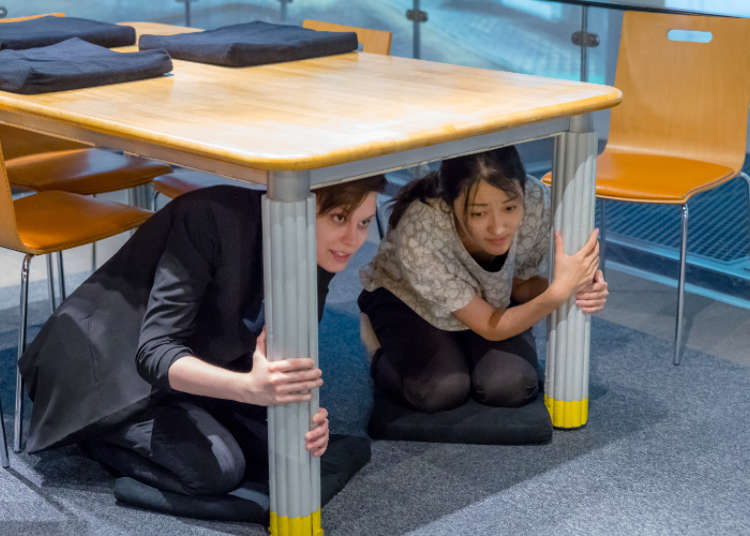
“This is it!” I thought and dug my fingers into the soft pillow, throwing myself under the table as fast as I could – and indeed, the time between the first tremor and the violent shaking that set in immediately afterwards couldn’t have been longer than two, maybe three seconds. I knew that it was a simulation and I’d be safe and sound no matter what happened, so, just like on roller coaster rides, my mind decided to release the stress of the experience by laughing. The background screens had moved on from the introduction to actual scenes from 2011: office workers scrambling to get under their desks, swaying lampposts and construction cranes, and after a moment or two I foolishly thought “Hey, it’s not that bad.”
Boy was I wrong. Just as I thought that the worst jolts were over, the platform shifted even more violently than before, making me as well as my table leg jerk forward. I screamed and so did Kei, half out of surprise and half out of pure shock. Even for her, a Japanese person who experienced her fair share of tremors, this huge quake was an entirely new experience. And all of a sudden, it was over, calming down almost as suddenly as it had started as the movie in the background went from scenes of the earthquake to scenes of the devastating tsunami. I hardly paid attention to it anymore, however, as I was occupied with taking care of myself and the slight sense of wooziness as I stepped off the simulator platform.
While my heart was still beating rapidly in my chest, Hirota-san explained once again how important it is to react quickly and with a calm head. Seeking cover under a table one too many times is much better than underestimating an earthquake that turns out to be stronger than anticipated and I nodded in agreement. After this experience, earthquake-underestimation-time is officially over. After the simulation, we were shown a short, multilingual documentation about the very earthquake we just experienced, once again emphasizing the importance of not only being prepared but also to look out for each other after the disaster strikes.
Kaji da~! Firefighting in Japanese
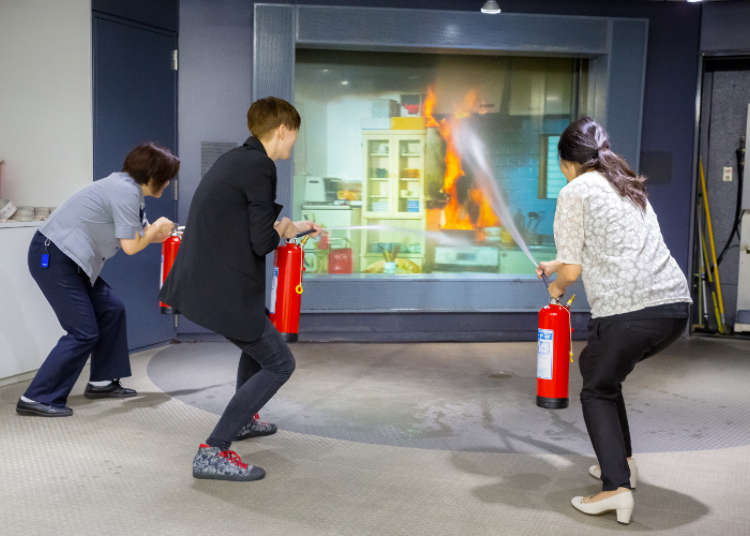
The next experience on our schedule was a lot less scary, simply because I was given a tool to defend myself: firefighting! Hirota-san led us to a room that was half kitchen, half exhibition about firefighting methods and tools. Handling a fire extinguisher isn’t hard at all, as our friendly guide explained: just pull the yellow pin, grab the hose by pulling it at its very front, and push the handle! This being said, I still didn’t do it properly the first time and although the kitchen fire, simulated on a waterproof monitor right in front of us, was extinguished, I had forgotten to yell “Kaji da~!” which means “Fire!” in Japanese.
While the earthquake simulator seemed like a fun but serious rollercoaster, the firefighting experience was incredibly rewarding. I genuinely enjoyed yelling FIRE! and trying my best to get the extinguisher ready as fast as I could – and to my great pleasure, I beat Kei in terms of speed.
After successful attempts of extinguishing a kitchen fire, Hirota-san explained the three main reasons for fires inside homes: the leading cause in Japan is tempura oil left to boil on the stove, followed by cigarettes thrown in the trash while not extinguished properly, and last but not least defect electrical cables, mainly behind microwaves and fridges, places where people hardly check.
Dark, Smelly, and Generally Uncomfortable
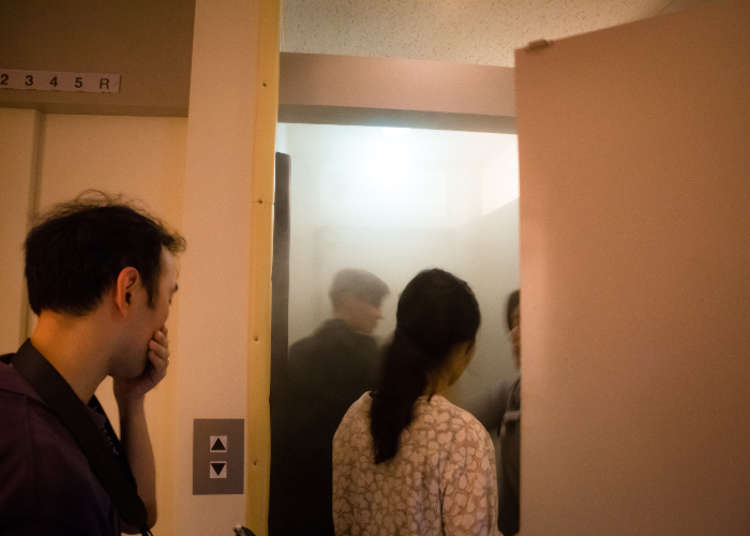
Having learned how to handle fires, it was time to tackle something that can be as dangerous as fire itself: smoke. Hirota-san led us to yet another section of the floor where the smoke maze. “There will be a siren, announcing a fire in the building. You need to escape. Before stepping through the first door, press a handkerchief to your nose and Mouth and crouch down as soon as you’re through the door. Follow the green emergency signs to find the exit, and hold on to the wall. It’s going to be dark”, she explained.
Yeah, she wasn’t kidding. As I threw open the first door to begin my journey through the maze, I stared at a glowing red window that clearly indicated a huge fire somewhere below. Just after a few crouching steps along the wall, however, I could hardly see a thing and despite the cloth pressed to my face, the stinging smell of smoke was almost overwhelming. Thanks to my long legs, I escaped the almost pitch-black smoke maze surprisingly quick, wheezing and coughing as I stumbled out the door to safety.
Learning can be Fun After All!
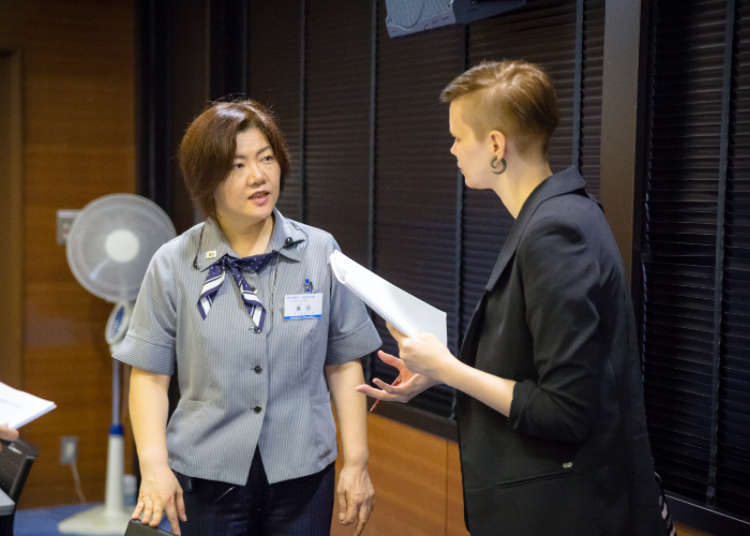
To tell the truth, I had not expected to be the Bosaikan such an amazing experience. Usually, these kind of disaster and survival training seminars have a reputation of being more on the boring side. The Life Safety Learning Center, however, does an excellent job in educating people in a very interesting and fun way, despite the seriousness of the topic itself. Every single experience is designed to give an authentic, realistic impression while making visitors feel safe and taken care of. Hirota-san wasn’t only one of the friendliest and most energetic persons that I’ve met in a while, she also made sure that we were well-informed not only on what to do and how to handle a situation but also about the background facts and statistics, be it quakes or fires.
The best part about the Bosaikan? For one, it’s completely free and while the instructors speak only Japanese, every single movie has multilingual subtitles and the flyers and booklets are available in a variety of languages. Especially the earthquake simulator is a huge recommendation for international visitors, specifically those who come from countries that simply doesn’t have tremors. The Bosaikan offers a great opportunity to not only learn how to react and how to be prepared, even if your stay in Japan is just a short one, it also makes it possible to get an idea of what an earthquake feels like.
Get Your Own Earthquake Experience
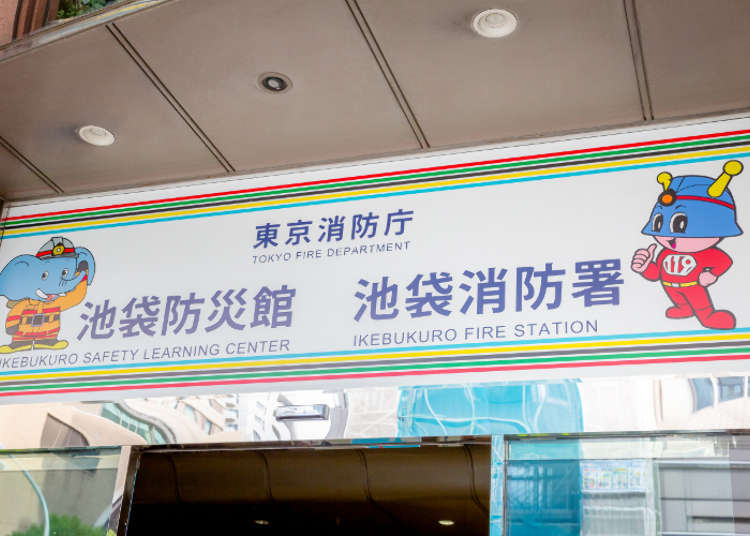
I wasn’t around when the Tōhoku Earthquake struck Japan in 2011 and the strongest tremors I’ve ever experienced were Shindo-4. So yes, I was wondering: how do I know whether it’s a big one, how do I know if I should hide under a table or not? In experiencing a big earthquake in a safe environment, I definitely have a much clearer idea of what to expect. Fear of the unknown is a big factor in feeling insecure and the Bosaikan does an excellent job to clear up both a lack of knowledge and misconceptions, whether it comes to quakes, fires, or first aid.
The full course with the experiences described in my articles takes two hours with the additional option of taking park in first aid training. Between 11:10 a.m. and noon, the Bosaikan hosts a short course that focuses on the earthquake simulator and the complementary documentary only, a convenient arrangement for visitors who are already well-informed about everything but tremors. So, what are you waiting for? Step in the simulator!
-
Ikebukuro Life Safety Learning Center池袋都民防災教育センター(池袋防災館)
- Address 2 Chome-37-8 Nishiikebukuro Toshima-ku, Tōkyō-to 171-0021
Having graduated in Japanese Studies in Berlin, she returned to Japan in 2014. She focuses on writing and translations from Japanese to English, contemporary culture and society, as well as history and lore of Japan.
- Area
- Category
*Prices and options mentioned are subject to change.
*Unless stated otherwise, all prices include tax.
Popular Tours & Activitiess
-

See Asakusa and Tokyo Skytree® in a New Light at the "Také Akari" Festival (Winter 2025-2026)
by: Guest Contributor
-

LaLaport TOKYO-BAY North Building Now Open: Shop, Dine & Enjoy Events at LaLa arena, Just 2 Stops from Disney
by: Wemmy Chau
-

A Travel Game Changer! Go Hands-Free Between Tokyo and Kyoto with LUGGAGE EXPRESS by JTB and JR Tokai
by: Guest Contributor
-

Black Friday 2025: These Are THE Japan Travel & Shopping Deals to Check Out
-

2025 Japan Autumn Color Report: Tokyo's Ginkgo Trees Starting to Glow
by: Timothy Sullivan
-

New Seibu L00 Series Launching in 2026! What to See Along the Tokyo-Area Golden Route
by: Guest Contributor
Inspiration for Accommodations
-

Enjoy Mt. Fuji from the Comfort of Your Room! Recommended Ryokan with Mt. Fuji View
-

Stay Near the Cherry Blossoms! Hotels for Cherry Blossom Viewing in Tokyo
-

Family-Friendly Hotels with Free Shuttle to Disneyland: Convenient Access for a Magical Stay
-

Top Ranked Hakone Hotels with Mt. Fuji View: Enjoy Stunning Scenery from Your Private Space
-

Convenient Tokyo Hotels with Airport Shuttle: Ideal for Families and Heavy Luggage
-

Stunning Tokyo Tower View Hotels: Enjoy Spectacular Scenery from Your Private Space
-

Convenient Asakusa Hotels with Kitchens: Ideal for Extended Family Visits
-

Experience Luxury: Hakone's 10 Best Five-Star Accommodations
-

Enjoy Mt. Fuji Autumn Leaves! Top Hotels Near the Popular Autumn Leaves Corridor
-

Experience Hakone Fall Foliage from Your Room with Stunning Views
-

The Story of Akihabara: How Tokyo’s Geek District Came to Be
-

Asking Japanese Expats: How Do Cities Around the World Compare to Tokyo?
-

Iconic Neighborhoods and More: Inside Tokyo's Top 10 Shopping Streets
-

JR Edition: Visit all of Tokyo in one Day with the Tokyo Metropolitan District Pass!
-
Ad

Japan Marks 150 Years of Railway Service! Our Report on the "Beyond Station Expo UENO" Cultural Event
-

Japan's Bath Culture: Tips You Should Know!
- #best ramen tokyo
- #what to buy in ameyoko
- #what to bring to japan
- #new years in tokyo
- #best izakaya shinjuku
- #things to do tokyo
- #japanese nail trends
- #what to do in odaiba
- #onsen tattoo friendly tokyo
- #daiso
- #best sushi ginza
- #japanese convenience store snacks
- #best yakiniku shibuya
- #japanese fashion culture
- #best japanese soft drinks



















